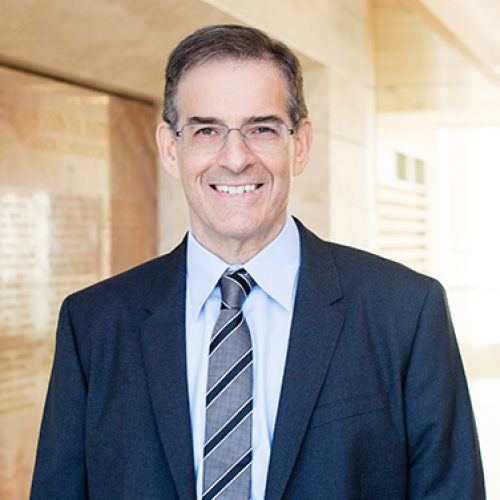Making Numbers Count
Throughout his career, Ron Brookmeyer has used biostatistics to address some of the most pressing public health concerns of our time. Now he’s making an impact as FSPH’s interim dean.

AT THE PINNACLE OF A CAREER during which his studies have drawn worldwide attention to the magnitude of major public health problems such as HIV/AIDS and Alzheimer’s disease, becoming interim dean of the Fielding School was far from Ron Brookmeyer’s radar. But since graduate school, Brookmeyer has been driven by a desire to make a difference. And so, when asked by UCLA’s campus leadership to take the reins of the Fielding School during the search process for a permanent dean, Brookmeyer, a professor in FSPH’s Department of Biostatistics since 2010, embraced the opportunity to make an impact in a new way.
Attaching numbers to global health problems can have a huge policy impact, as long as the numbers are backed by solid science.
Brookmeyer’s interest in consequential work can be traced to his days as a PhD student in statistics at the University of Wisconsin, when he chose to specialize in biostatistics as a way to address human health. At the time, his focus was on developing statistical methods to test the efficacy of new cancer treatments. Upon graduating Brookmeyer took his first academic position, in the public health school at Johns Hopkins University. His introduction to the field was eye-opening. “I had been studying whether a chemotherapy drug might help patients live a certain number of weeks or months longer,” Brookmeyer explains. “That’s obviously very important, but through public health I realized that if you could prevent the disease in the first place, that would be so much more powerful.”
It was 1981, the same year a UCLA physician reported the first cases of a complicated new disease that would later become known as AIDS. In 1984, the Multicenter AIDS Cohort Study was launched to learn the natural history of the disease at four sites, including Hopkins and UCLA. Brookmeyer became an active research participant at the Baltimore site. “At first, it wasn’t even known that AIDS was an infectious disease, and of course there was no test for HIV,” Brookmeyer recalls. “But as we started to look at it, we began to see that we might have a major epidemic on our hands.”
As the contours of the emerging epidemic became clearer, Brookmeyer set out to determine how widespread it was likely to become, applying the statistical methods he had used as a graduate student studying cancer survival. But with AIDS there was an important wrinkle — the long incubation period, or time between when an individual became infected and when he or she became sick.
With the discovery of HIV as the cause and the introduction of the test for the virus in 1985, Brookmeyer and his research colleagues calculated that the incubation period was, on average, close to 10 years. Brookmeyer then developed a method to estimate, based on the number of cases reported and the incubation period, how many people were carrying the virus and how widespread the epidemic was likely to become. On December 6, 1986, he co-authored a landmark paper in The Lancet arguing that the 27,000-plus cases reported up to that point represented the tip of the iceberg. The study received worldwide attention, and the projections proved prescient.
It was the first foray into what would characterize Brookmeyer’s research throughout his career — immersing himself in the substance of a major public health problem and then using statistics, epidemiology and information sciences to develop models that gauge its current and future scope. “Data is power,” Brookmeyer says. “Attaching numbers to global health problems can have a huge policy impact, as long as the numbers are backed by solid science.”
His ability to use numbers for impact hasn’t been lost on his colleagues. “Ron Brookmeyer is a biostatistical leader whose hallmark has been to advance research at the interface of statistical methodology and major health impact,” says Karen Bandeen-Roche, the Hurley Dorrier Professor and Chair in Biostatistics at the Johns Hopkins Bloomberg School of Public Health, where Brookmeyer once headed the interdepartmental MPH program.
In 2001, in the weeks following the September 11 attacks, Brookmeyer was again called on to attach numbers to a high-profile public health concern. After letters containing anthrax spores were mailed to several news-media and U.S. Senate offices, Brookmeyer was asked to develop estimates of how many people were exposed to the potentially fatal powder and the public health impact of initiating antibiotics for thousands of possibly exposed postal workers at mail sorting facilities. His mathematical models also helped to inform public health preparedness efforts, as did later studies about the utility of an anthrax vaccine.
By that time, Brookmeyer was deep into a research topic that continues to be a major focus — putting numbers on the looming epidemic of Alzheimer’s disease. Brookmeyer first gained attention with a study in the late 1990s in which he projected that the number of Alzheimer’s cases in the U.S. would nearly quadruple by 2050. His 2007 study forecasting the same quadrupling of the disease worldwide became the most widely cited of Brookmeyer’s career. Brookmeyer’s models also allowed him to project the potential impact of future therapies and other strategies to prevent or delay the onset of the disease and progression of symptoms. “Everyone wants to hit the home run — to find a cure, or be able to prevent all cases of the disease — but even if we could delay it a few years, given that it’s a disease of the elderly, it would have a huge public health impact,” he notes. Most recently, Brookmeyer published the first estimates of the numbers of Americans with mild cognitive impairment or preclinical Alzheimer’s disease, based on a newly developed imaging test that can detect changes in the brain that predate clinical symptoms.
Brookmeyer has had little time for his research since last November 1, when he assumed the role of FSPH’s interim dean. “It’s a different life,” he says, laughing. “But it’s given me an appreciation for the tremendous work taking place at our school, and has allowed me to collaborate with other deans and build bridges throughout the university. Public health is an interdisciplinary, problem-solving field, so having the chance to get involved in those kinds of efforts at UCLA is a great opportunity and honor.”
In his new role, Brookmeyer spends a fair amount of time explaining to outside groups the importance of the Fielding School’s contributions. In doing so, he conveys the same message he learned upon his introduction to public health at the start of his career. “If you want to have an impact on people and on society, this is a fantastic field,” he says. “There will always be new challenges, but a strong foundation in core public health competencies allows us to address those challenges. Here at the Fielding School, we are providing that foundation.”
